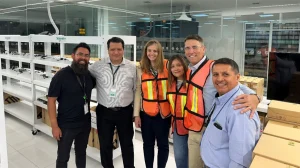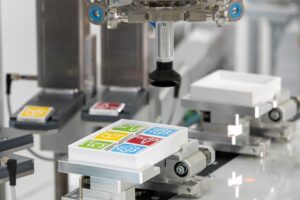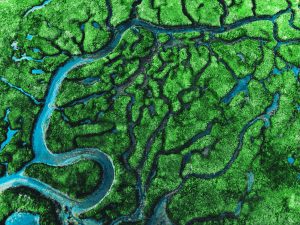The importance of water can’t be overstated. We use it for cooking, cleaning, growing food, and many industrial activities.
However, the demand for water is increasing and is projected to outstrip supply by 2030. Rising temperatures and erratic weather patterns are also straining water resources. Aging infrastructure across the globe is also impacting supply due to water loss, inefficiencies, and increased carbon emissions. For example, U.S. water utilities emit energy-consumption-related greenhouse gasses equivalent to more than 9 million cars and lose 6 billion gallons of potable water to leaks daily. The need for efficient water management is more critical than ever, and it works! Some water utilities have achieved less than 5% water loss, reduced energy consumption by over 30%, and cut operating costs by more than 20%, all while maintaining the same service quality and lowering carbon emissions.
This is where digital technologies come into play. Advances such as artificial intelligence (AI), machine learning (ML), and Digital Twins have enormous potential as transformative solutions. These tools enhance the water industry’s ability to monitor, control, and optimize water use precisely.

Let’s explore these innovative technologies, which will help vital water infrastructure move closer to net-zero emissions and promote more efficient management.
The ripple effect of AI, machine learning, and data analytics
AI-driven water management approaches are a pivotal step toward sustainable and resilient water systems. Artificial intelligence and machine learning empower water utilities to effectively use extensive data, from many sources, to transform their water management being proactively supported by the technology. With AI, utilities can monitor their water systems in real time, make quick adjustments based on smart recommendations, and predict potential infrastructure failures – thereby boosting efficiency and responsiveness – by utilizing a variety of features. This proactive approach can prevent costly breakdowns and ensure the continuous availability of water services. The technology also extends water infrastructure lifespan, leading to substantial cost savings and improved service reliability.
These same algorithms can also help meet demand, improve distribution, and minimize energy use by analyzing consumption patterns and optimizing water flows. They can quickly discover water leaks and losses in the network, cutting down on waste and conserving valuable water resources.
The rising tide of digital twins in sustainable water management
Using software to analyze data and display contextualized insights improves efficiency during all phases of a plant’s lifecycle.
Digital twins – a virtual model of physical water systems and processes – are also significantly impacting the water industry. Digital twins address critical challenges like aging infrastructure, water scarcity, and sustainability demands. This technology enables a new understanding of complex water networks by integrating data streams from diverse sources like maintenance data. It also allows for real-time monitoring and simulation of energy supplies, helping to reduce carbon emissions and enhance decision-making and operational efficiency. Leaders at AVEVA software are developing platforms that leverage operational alogrithms and allow for full digital continuity with the use of digital twins.
Predictive analysis helps water facility managers anticipate system failures or inefficiencies before they escalate. This capability is vital for maintaining the reliability and quality of water services, minimizing operational costs, and extending infrastructure lifespan.
In addition, digital twins working in concert with predictive analysis can provide advanced simulations and evaluations of operational scenarios. These simulations are key to improving efficient water distribution strategies, energy utilization, and treatment processes. This contributes to environmental sustainability by conserving resources and reducing waste. As an example, hydraulic modeling software can simulate the water quality, pollution event impact, and water pressure that can indicate a pipe issue. They have also been used to predict potential events up to five days in the future and a proactive forecast to help operate a facility.
The uneven adoption of digital innovation
Digital technologies are advancing sustainable water management worldwide, enhancing efficiency and resilience. However, adoption rates vary across regions due to differing economic, regulatory, and water-related challenges. Many areas across the globe are leading the way in integrating intelligent solutions like smart metering, data analytics, AI, and IoT-based monitoring into their water systems. This diversity in adoption represents challenges and opportunities for tailored solutions that meet the unique needs of each region.
The water sector’s adoption challenges include technical complexities, costs, and cultural hesitancy. These obstacles can be effectively addressed through strategic initiatives and change management programs. Integration of data management, IT experts, and educational programs help demystify technology. Pilot projects demonstrate tangible value and collaborative partnerships can pool expertise and resources. Additionally, supportive policies with financial incentives can accelerate the transition to more efficient and future-ready water management systems. By embracing these multifaceted strategies, the global water sector can unlock the full potential of digital innovation.
Helping you navigate the currents of change
Digital innovation paves the way to a sustainable water future, and Schneider Electric stands at the forefront of this transformation. As a trusted advisor in the water and wastewater sector, we offer a consultative, customer-centric approach to revolutionize your operations.
Dive into our suite of innovative water management solutions designed to digitally transform the entire water cycle. Our comprehensive offerings span water and wastewater treatment plants, desalination facilities, and sanitation networks. Discover how our successful partnerships in the water industry are setting new standards for efficiency and sustainability.




Add a comment